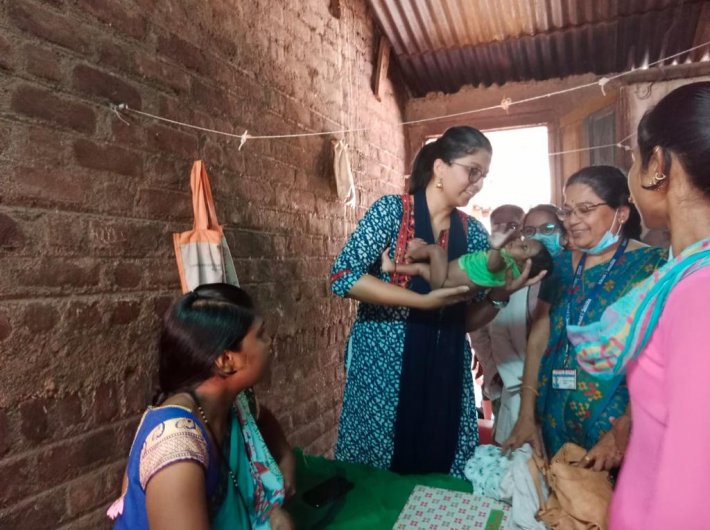An IAS officer writes about a project that’s improving weight gain among babies in Nandurbar district of Maharashtra
Our hearts almost skipped a beat when we heard community health officer (CHO) Dr. Sandeep Kakuste’s success story with baby Pinki Lakhan Patil, who was born underweight in a brick kiln. Pinki weighed 1.7 kg at birth. As she was on exclusive breastfeed she could not have gained weight by any other method. However following the techniques of ‘Health Spoken Tutorials’ of IIT Bombay, Pinki gradually gained weight and weighed 2.5 kg in 14 days – a weight gain of 800 grams within a fortnight. CHO Dr Rakesh Patil says that never in his career of seven years has he seen weight gain due to breastfeeding at this pace.
Nandurbar has an exclusive breastfeeding rate of 86.6%. (The breastfeeding rate is an indicator that measures if the child has had breastmilk exclusively in the first six months of its life). Going by this mathematical figure, it would mean that in 0-6-month-old babies, incidence of underweight/wasting/stunting would be proportionately less in the district as children only drink their mother’s milk and nothing else.
Yet as per NFHS-5 data, Nandurbar’s stunting, wasting and underweight indicators remain very high. As many as 57.2% children are underweight, 45.8% are stunted and 30.7% wasted. This means that the high exclusive breastfeeding rate is not translating into reduced malnutrition amongst children.
Speaking of breastfeeding, to a layperson like me the only image and explanation that conjured up is that of a mother holding her child to her breast, until I came across Health Spoken Tutorials that can be easily termed ‘mechanical engineering’ on the phenomenon of breastfeeding. These tutorials helped us simplify the ‘hold and latch’ in a manner so effective that we started getting positive and good results with corresponding proportionate weight gain in children.
In field when I saw ‘cradle hold’ practices with a child’s head often tilted towards the mother, I wondered if we as grownups could ever drink water in a similar manner from a glass or a bottle with our head tilted sideways. In nipple feeding, I have often seen the mother holding her child to her breast as she continues to do farm work.
It is plain logic that the child should be held to the breast in a manner that makes it easiest for the child to drink milk. The idea of ‘milk transfer’ from the mother’s breast to the child is central to breastfeeding. The idea of a ‘correct latch’ of the child on the mother’s breast is also central to breastfeeding.
During my visits to the district hospital I saw many babies low on energy and crying and many concerned mothers would complain, “Ye doodh nahi pi raha hai.” This made me curious as to why the hungry child was resisting drinking the mother’s milk.
The tendency more often is to blame the beneficiary for their handicaps – illiteracy, ignorance and poverty. I have often heard comments like “Mata khud hi bachche ka bhala nahi chahti” or “Yeh log itne bachche kar lete hai ki sab pe dhyan nahi dete”.
The question that comes to mind is: Are we really helping these mothers with an easier and effective technique or are we only justifying our own incompetencies?
The mothers that Dr Kakuste and Dr Patil helped were so elated to see weight gain in their children that they stuck to the Tutorials’ new skill of breastfeeding by following it to a tee.
These Health Spoken Tutorials not only presented to us a different hold or a new technique, but also gave us clear analogies as to why we need to be convinced with these instructions. For example, we came to know that a simple extension in the neck of the child during breastfeeding helps in the swallow process, just as we extend our necks while we drink water. We also came to know that complete alignment of the child towards a mother’s breast increases its comfort as it drinks its mother’s milk.
The logic behind each idea and micromanaged breakdown of the ‘hold’ only helped us to push these techniques wide and deep into the health systems and as well as ICDS which so far we believed only doctors could understand. Our ASHA tais and Anganwadi sevikas absorbed these tutorials.
Talking of weight gain in a child between 0-6 months of age, the only input we have is that of the mother’s milk. We do not quantify it because we haven’t been able to store this on a larger scale. For example, when we look at growth velocities in Nandurbar we find it very normal for a child of 0-6 months of age to have a monthly weight gain of 300-350 gram. This essentially translates to nearly 10-12 gram per day.
While the National Nutrition Mission guidelines recommend 28 grams weight gain per day, the Health Spoken Tutorials have helped us achieve weight gain of 35-40 gram and even 50 grams per day.
What did we learn here? That while the mothers of these hungry babies have been taught about exclusive breastfeeding for the first six months, they do not know effective breastfeeding. Hungry tummies of these small babies all around us, who cannot speak, get overshadowed in the helplessness of the mothers to transfer their milk to their stomachs.
We thank Dr Rupal Dalal of Health Spoken Tutorials, IIT Bombay, and Dr Devaji Patil for helping us lay down the implementation framework. We offer our appreciation and gratitude to Nandurbar collector Manisha Khatri for being a solid anchor in supporting this project.
Minal Karanwal, Sub Divisional Officer, Project Officer, Nandurbar district (Maharashtra), is 2019 batch IAS officer.
